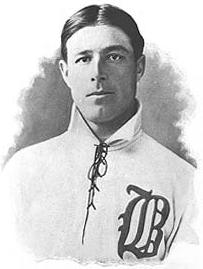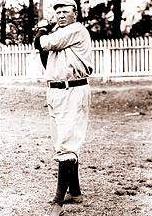|
1901: In the Beginning...
The Birth of Red Sox Nation
 |
As hard as it may be for their partisans to believe today, there was indeed a time when the Boston Red Sox did not exist. This flaw in the national culture was corrected in 1901.
- Donald Honig |
It was in 1901 that Ban Johnson, the president of a small but successful group of mid-western
minor league teams known as the Western Association, declared his circuit a major league.
The National League had formed in 1876. It consisted of twelve teams, had a salary cap of
$2,400 per year, and charged fans 50¢ to attend games. Johnson originally planned to
open with his former Western Association teams in Chicago, Cleveland, Detroit, Buffalo, and
Milwaukee, as well as newly-relocated teams in Washington, Baltimore, and Philadelphia.
When the National League owners refused to acknowledge his new league, he decided
to compete directly in more National League cities. Fortunately for generations of New
Englanders, he chose to move his Buffalo team to Boston.
The owner of the new Boston team was Charles W. Somers, a millionaire who also invested in
the teams in Chicago, Cleveland, and Philadelphia. They played in
the Huntington
Avenue Grounds, today part of Northeastern University. The park was constructed in less
than two months. The stands were made of wood, and fire was a constant threat. The park
seated 7,000, but crowds were also permitted to stand in the outfield behind ropes. (And with
the center field fence 530 feet from home plate, there was plenty of room for them there!)
Games cost only 25¢, and fans quickly began supporting the new team. Even that first year,
attendance was better at their games than for Boston's National League team. (Both teams were
originally referred to simply as the Bostons, but to differentiate the two teams, they came to
be called the Americans and Nationals. Other nicknames, like Pilgrims, Somersets, or Puritans,
were invented by the press but not used by the teams themselves or the fans.)
 Ban Johnson presided over the transactions of his new league. For the American League to
survive, it was vital that his teams in cities with existing National League teams do best,
so he gave the Chicago, Philadelphia, and Boston teams the "rights" to signing the best
National League players.
The Boston Americans were able to lure a number of stars away from the National League by
offering salaries as high as $4,000. John "Buck" Freeman, Ted Lewis, Chick Stahl, and
Jimmy Collins were four ex-Boston Nationals who played for the Americans in
their inaugural season. Freeman was a power-hitting first baseman, who led the team in
hitting that season. He also led American League first basemen with 36 errors, and was
later moved to the outfield where he would be less of a fielding liability. Lewis was a
right-handed pitcher who had won 26 games for the Boston Nationals in 1898. Stahl, the center
fielder, would later manage the team.
Ban Johnson presided over the transactions of his new league. For the American League to
survive, it was vital that his teams in cities with existing National League teams do best,
so he gave the Chicago, Philadelphia, and Boston teams the "rights" to signing the best
National League players.
The Boston Americans were able to lure a number of stars away from the National League by
offering salaries as high as $4,000. John "Buck" Freeman, Ted Lewis, Chick Stahl, and
Jimmy Collins were four ex-Boston Nationals who played for the Americans in
their inaugural season. Freeman was a power-hitting first baseman, who led the team in
hitting that season. He also led American League first basemen with 36 errors, and was
later moved to the outfield where he would be less of a fielding liability. Lewis was a
right-handed pitcher who had won 26 games for the Boston Nationals in 1898. Stahl, the center
fielder, would later manage the team.
Jimmy Collins was heralded as baseball's best third baseman. He was adept at fielding bunts
barehanded and turning them quickly into outs, a skill much appreciated in the
dead-ball era. In addition to playing,
he was the team's first manager, and also had the ability to sign players to contracts. He
had led the National League with 15 home runs in 1898, and remained a solid hitter in the
American League.
The Americans were also able to snare the greatest pitcher of the day,
Denton True "Cy" Young. Young had been pitching in St. Louis,
but he didn't like the heat, and welcomed the chance to play in a cooler climate. He had
been pitching since 1890, and had won 20 or more games in nine of those eleven seasons.
He had already won 286 games, more than half of his all-time record 511 career wins. Young
threw a fastball and a couple of different curveballs, and was very durable, often pitching
on one or two days' rest. Lou Criger was Cy's favorite catcher, and he also came to Boston
from St. Louis. Criger was no offensive star, but was an excellent defender. He was able
to throw out runners such as the speedy Ty Cobb with ease. Legend has it that one day Cobb had
had enough.
He told Criger that the next time he got on base, he would steal all the way around - and
sure enough he did, stealing second, third, and then home. ("I'll be damned," said Criger.)
 The 1901 Boston Americans also featured second baseman Hobe Ferris, shortstop Freddy Parent,
right fielder Charlie Hemphill, left fielder Tommy Dowd, catcher Ossee Schreckengost, and
pitchers George Winter, Fred Mitchell, and Nig Cuppy. They trained for a month in
Charlottesville, Virginia, (batting and fielding practice in the morning, and hikes through
the woods in the afternoon) before playing their first game on April 26 in Baltimore. Win
Kellum started the first game, and they lost, 8-6. They had a 5-5 record by the time they
played their first home game on May 8, 1901. 11,500 fans
packed the ballpark to see Cy Young and his team beat Philadelphia 12-4.
The 1901 Boston Americans also featured second baseman Hobe Ferris, shortstop Freddy Parent,
right fielder Charlie Hemphill, left fielder Tommy Dowd, catcher Ossee Schreckengost, and
pitchers George Winter, Fred Mitchell, and Nig Cuppy. They trained for a month in
Charlottesville, Virginia, (batting and fielding practice in the morning, and hikes through
the woods in the afternoon) before playing their first game on April 26 in Baltimore. Win
Kellum started the first game, and they lost, 8-6. They had a 5-5 record by the time they
played their first home game on May 8, 1901. 11,500 fans
packed the ballpark to see Cy Young and his team beat Philadelphia 12-4.
Fans took quickly to the new team. Games were cheaper, and several of their favorite
stars had moved across town from the National League team to the Americans. They believed that
the Nationals' management had been underpaying their favorite players, and were happy to see
them on a new team. The most vocal fans of Boston's Americans were the Royal
Rooters. They were a group several hundred strong, led by Michael T. "Nuff Ced" McGreevey.
McGreevey owned the Third Base Saloon, which got its name because, like third base, it was
the last stop before home. He earned his nickname by shouting "'Nuff said!" to end barroom
disputes. The saloon was Boston's original sports bar - it was decorated in a baseball
theme, with pictures of the players, and a scoreboard on the outside wall. Nuff Ced
befriended several of the players, and even took infield practice with them a few times.
He led a raucous group of fans at every game, and embarked on road trips with the team.
Today's Red Sox have the K-Men, but
Nuff Ced McGreevey and the Royal Rooters were the founding fathers of Red Sox Nation.
| W | L | Pct. | GB |
|---|
| Chicago | 83 | 53 | .610 | — |
| Boston | 79 | 57 | .581 | 4 |
| Detroit | 74 | 61 | .548 | 8½ |
| Philadelphia | 74 | 62 | .544 | 9 |
| Baltimore | 68 | 65 | .511 | 13½ |
| Washington | 61 | 73 | .455 | 21 |
| Cleveland | 55 | 82 | .401 | 28½ |
| Milwaukee | 48 | 89 | .350 | 35½ |
|
The 1901 team gave them a lot to cheer about. Having lured several National League
players over, they out-performed the city's National League team. Buck Freeman was the team's
best hitter, leading the league with a .345 average, and adding 114 RBI and 12 home runs,
which was only two less than the league's leader, Napoleon Lajoie. Player-manager Jimmy Collins
hit .332 with 42 doubles and 16 triples. Pitchers Ted Lewis and George Winter each won 16
games, but Cy Young led the league with a 33-10 record, 158 strikeouts, and a 1.62 ERA,
just the sort of stats you'd expect from a Cy Young Award winner. (Until 1904, teams played only
140 games - or less, if there was bad weather - making his 33 wins that much more remarkable.)
Perhaps in a foreshadowing of seasons to come, the Boston Americans got off to a good start and
stayed in the pennant race all season long. They were a strong-hitting team, leading the
league in home runs, but ultimately finished in second place, their record of 79-57 leaving them
four games behind Chicago. The Nationals finished fifth in their
league, at 69-69. From that season on, Boston was an American League town.
The 1901 Boston Americans - Hitting
AB BA H 2B 3B HR R RBI SB PO A E
_____________________________________________________________________________
1B B. Freeman 490 .345 169 23 15 12 86 114 17 1279 55 36
2B H. Ferris 523 .250 131 16 15 2 68 63 13 359 450 61
3B J. Collins 564 .332 187 42 16 6 109 94 19 203 328 50
SS F. Parent 517 .306 158 23 9 4 87 59 16 260 446 63
LF T. Dowd 594 .268 159 18 7 3 104 52 33 302 12 20
CF C. Stahl 515 .309 159 20 16 6 106 72 54 277 12 13
RF C. Hemphill 545 .261 142 10 10 3 71 62 11 188 22 17
C O. Schreckengost 280 .304 85 13 5 0 37 38 6 301 102 30
C L. Criger 268 .231 62 6 3 0 26 24 7 380 110 16
|
Pitching
W L Pct. ERA G GS CG SHO IP H BB K
________________________________________________________________________
P C. Young 33 10 .767 1.62 43 41 38 5 371.1 324 37 158
P T. Lewis 16 17 .485 3.53 39 34 31 1 316.1 299 91 103
P G. Winter 16 12 .571 2.80 28 28 26 1 241.0 234 66 63
P F. Mitchell 6 6 .500 3.81 17 13 10 0 108.2 115 51 34
P N. Cuppy 4 6 .400 4.15 13 11 9 0 93.1 111 14 22
|
Also see
Complete statistics for the 1901 team at baseball-reference.com
1901 game log at retrosheet.org
A couple of things strike me about these stats: The number of
errors is amazing. (Of course, gloves were different and Joe Mooney wasn't the groundskeeper yet.)
And with the pitchers throwing
as many innings as they did, you'd expect them to have a lot of wins and complete games.
But see Cy Young's stats next to some of his fellow deadball era pitchers, and he's still
head and shoulders above the rest - 33 wins, 371 innings, and only 37 walks!
|




